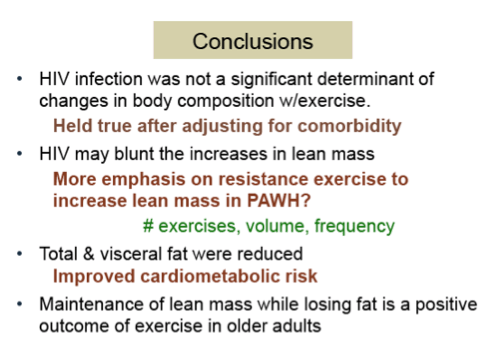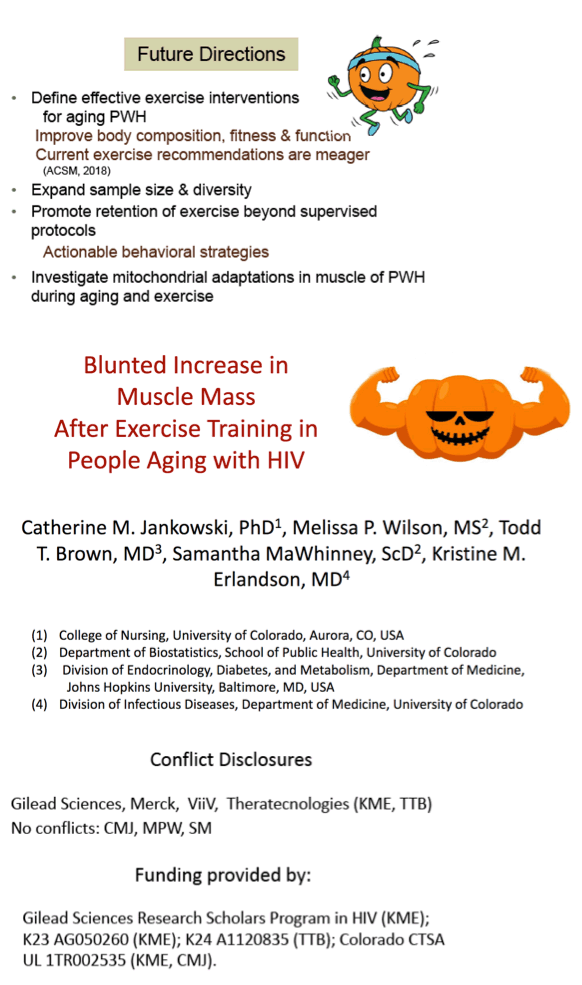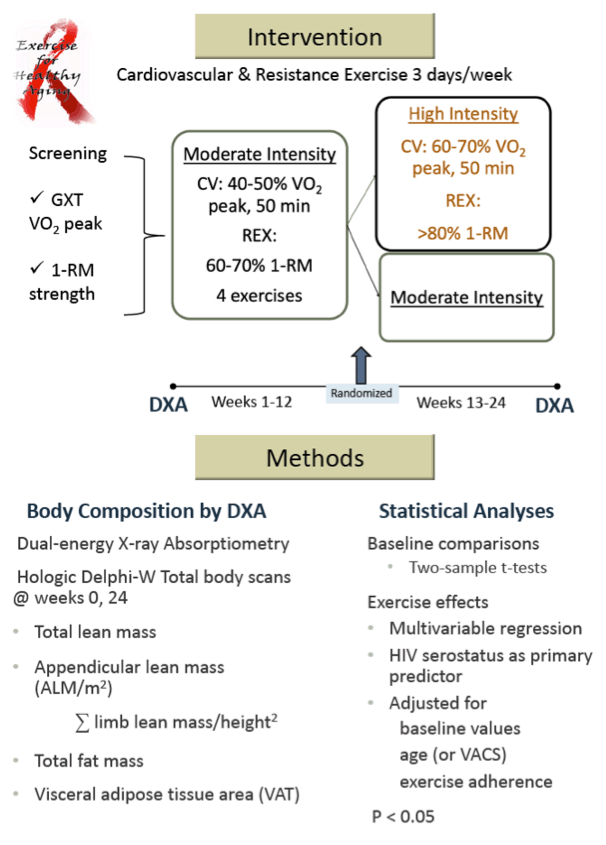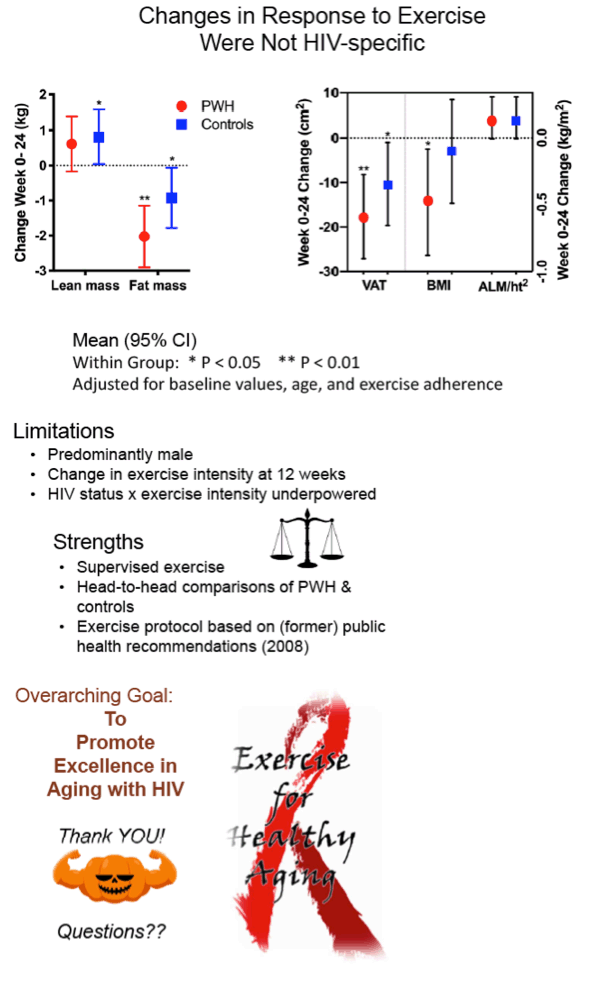 |
 |
 |
| |
Blunted Increase in Muscle Mass
After Exercise Training in People Aging with HIV
|
| |
| |
10th International Workshop on HIV and Aging, October 10-11, 2019, New York
Reported by Jules Levin
Catherine M. Jankowski, PhD1, Melissa P. Wilson,
MS2, Todd T. Brown, MD3, Samantha MaWhinney,
ScD2, Kristine M. Erlandson, MD4

program abstract
Blunted increase in muscle mass after exercise training in people aging with HIV
Jankowski C1, Wilson M2, Brown T3, MaWhinney S2, Erlandson K4
1University Of Colorado College of Nursing, Aurora, United States, 2Department of Biostatistics, School of Public Health, University of Colorado, Aurora, United States, 3Division of Endocrinology, Diabetes, and Metabolism, Department of Medicine, Johns Hopkins University , Baltimore, United States, 4Division of Infectious Diseases, Department of Medicine, University of Colorado, Aurora, United States
Background: Newer antiretroviral therapies (ART) with less toxicity have prolonged the lives of people living with HIV (PLWH). Muscle wasting and lipoatrophy are now rare. Instead, older PLWH are facing age-related sarcopenia and increasing adiposity. Interventions to reverse these changes are needed. We previously found that older PLWH had similar improvements in physical function as uninfected controls (NEG) following an exercise intervention. Here, we compared adaptations in body composition.
Material & Methods: Sedentary PLWH (on ART >2 years) and NEG, ages 50-75 years, completed a 24-week, moderate- to high-intensity supervised cardiovascular and resistance exercise intervention. Total body lean mass (LEAN), appendicular lean mass adjusted for height (ALM/m), total body fat mass (FAT), and visceral fat area (VFA) were measured pre/post intervention using dual energy x-ray absorptiometry. Comorbidity burden (Veterans Aging Cohort Risk Index; VACS) and use of testosterone and statins were collected at baseline. Participant characteristics are reported as the median {IQR} or mean (95% CI). Multivariable regression analyses were adjusted for age or VACS and exercise adherence.
Results: The majority of participants (27 PLWH, 28 NEG) were male (93%), white (80%) and non-Hispanic (86%). PLWH and NEG were of similar age [56 years {52, 61}; 60 years {54, 64}, respectively; P>0.05]. PLWH were diagnosed with HIV 23 years {16, 28} prior, ART duration was 17 {8, 19} years, had a CD4 count of 548 cells/μl {416, 772}, and all had plasma HIV-1 RNA <50 copies/mL. Testosterone use was more prevalent in PLWH than NEG (18% vs. 7%; P < .05) but statin use was similar (41%). More PLWH had a VACS score > 20 [56.2% vs. 24.3%; P < .05].
Before training, PLWH had significantly less FAT than NEG [20.6 kg (17.7, 23.6) vs. 27.2 (24.0, 30.4); P < 0.01] but similar (P > 0.05) VFA [PLWH 184 cm (151, 217); NEG 211 cm (184, 237)], LEAN [PLWH 57.7 kg (61.1, 54.2); NEG 60.0 (56.4, 63.6)] and ALM/m [PLWH 8.6 kg (8.1, 9.1); NEG 8.9 (8.5, 9.3)]. After training, LEAN increased significantly in NEG [0.8 kg (0.0, 1.6); P = 0.04)] but not in PLWH [0.6 kg (-0.2, 1.4); P =0.12]. ALM/m increased (P=0.06) in both groups [PLWH 0.14 kg/m (-0.01, 0.29); NEG 0.15 kg/m (0.0, 0.29)]. FAT decreased significantly in PLWH [-2.0 kg (-2.9, -1.1); P < 0.001] and NEG [-0.9 kg (-1.8, 0.0); P = 0.04]. VFA also decreased significantly in PLWH [-17.7 cm (-8.2, -27.1); P < 0.001] and NEG [-10.3 cm (-1.0, -19.6); P = 0.03]. Exercise adherence was a significant (P < .05) covariate of the decreases in FAT and VFA; VACS was not.
Conclusion: A supervised exercise intervention without dietary intervention led to modest total and visceral fat loss, with preservation of lean mass. The changes in response to exercise were not HIV-specific, except that the increase in lean mass (a surrogate for muscle mass), was blunted in PLWH and not explained by their greater comorbidity. During exercise, older PLWH may need more resistance exercise than NEG to stimulate muscle hypertrophy and increase lean mass.





|
| |
|
 |
 |
|
|